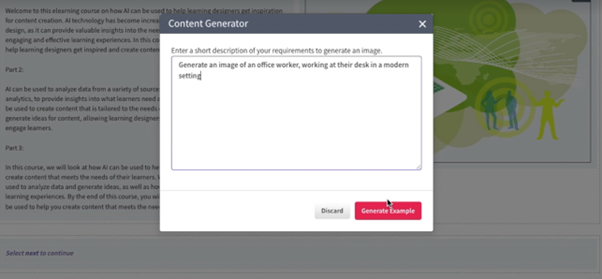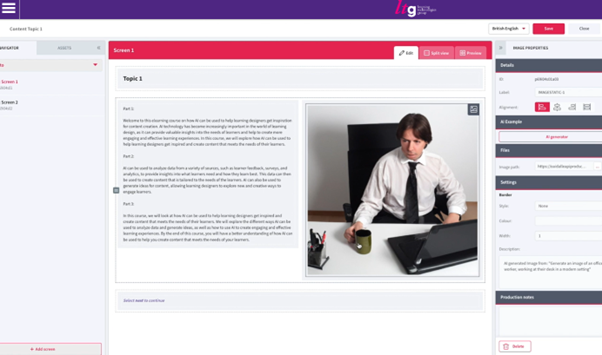Many learning and development professionals, especially those involved in learning content design and development, know the hassle of finding the right content for eLearning, such as images, infographics, job aids, and other visuals.
Content designers, graphic artists, and media developers spend endless time scrolling through stock photo libraries to find adequate images for their content.
Often times, there are limited options to choose from, especially when it comes to photos of people with a certain age, ethnicity, and emotion.
With AI, this changes. Learning professionals no longer have to rely on preexisting photos. Now, they can use tools such as Midjourney, Stable Diffusion, DALL-E and others to create new images based on their own very specific and individual requirements.
Note: The use of AI-generated images is a gray area. There are many concerns related to copyright and the safe and transparent use of such images. The use of AI in image generation remains nascent and the legal ramifications are currently under investigation. Determining whether AI-generated images violate intellectual property rights is a multifaceted issue without a simple, definitive response.

Considerations and Guiding Principles
When using AI to create images, learning professionals should take into consideration that AI tools are trained using existing image databases. There are many examples showing how biased AI applications can be and how dependent they are on their training material and trainers. It is important to ensure that, as learning professionals, we embrace diversity, equity, and inclusion through AI-generated images for improved quality, safety, and accuracy.
Respecting intellectual property, rights, patents, and copyright obligations around the use of AI-generated images is of tremendous importance. As learning professionals, we should ensure safe and reliable use of any image we use in our work. We should be transparent regarding the use of these images, which prompt was used, and which AI tool and version was used to generate the image.
Note: The U.S. copyright office reiterated that copyright protection depends on the amount of human creativity involved, and that the most popular AI systems likely do not create copyrightable work. The EU has put together an early EU agreement that could pave the way for the world’s first comprehensive laws governing the technology. According to this agreement, companies deploying generative AI tools will have to disclose any copyrighted material used to develop their systems.
Prompt Design and Engineering
Watch the following video to learn more about prompting and the importance of being as specific as possible:
Learning professionals should learn the key principles of prompt design and prompt engineering to get the images they need for their learning content.
Prompt Design
Prompt design refers to formulating the question or instruction that is later used by a language model. This means carefully writing the input text in order to get the desired output or response from the tool. The goal of prompt design is to provide clear instructions, specify the format or structure of the desired response, and guide the model to produce the desired output. Then, use the response as inspiration to create content or images using available development tools.
Prompt Engineering
Prompt engineering is the ongoing process of refining and optimizing the original prompt design to improve the performance and output quality of the language model. This includes experimenting with different prompts, adding context or constraints, customizing the instructions, or including additional hints to control the model’s behavior.
For example, here is the prompt used in the video to produce the final image. The image was created in Midjourney, using ChatGPT.


The more details and specifics that learning professionals provide in the prompt, the faster and more direct the output is.
Example Prompt Details
Use these prompt details to craft images for your learning content:
- Descriptive keywords
- Subject
- Style and environment
- Desired emotions and mood
- Details such as time of day or lighting conditions, contrast, color effects, backgrounds, style of photograph
- Type of film, including camera type and lens type
- Aspect ratio such as 16:9 or 3:2
Prompting for images can be done within an AI chatbot like ChatGPT, an AI image generation tool like Midjourney, Stable Diffusion, or DALL-E or even within a learning authoring tool. Different learning content authoring tool providers, such as Gomo Learning, are currently prototyping and working on ways to integrate AI into their tools without the need to log on to an additional tool.


The future of using AI-generated images in learning content is promising. With careful planning and consideration of the ethical use of AI-generated imagery, the future of the learning and development professional’s work can become easier and more efficient. Using AI to generate images can be a powerful tool that can help learning professionals do their work more robustly and effectively.
For More on Artificial Intelligence
Podcast Episode #107 | Harnessing AI Tools for Productivity and Creativity
Article | What ChatGPT and Generative AI Could Mean for Learning
